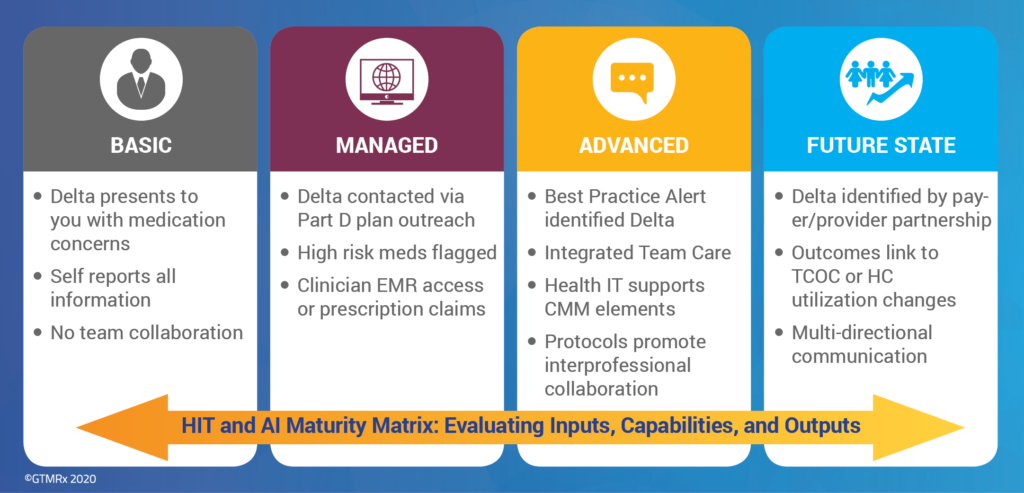 By Molly Ekstrand, BPharm, BCACP, AE-C, Consultant with North Star Medication Optimization, LLC; Distinguished Fellow, GTMRx Institute
By Molly Ekstrand, BPharm, BCACP, AE-C, Consultant with North Star Medication Optimization, LLC; Distinguished Fellow, GTMRx Institute
Twitter: @GTMRxInstitute
This is what we know: Health IT is essential to comprehensive medication management. And you don’t have to be a multi-billion-dollar health system to make it work.
Access to point-of-care clinical information, enabled by technology, allows care teams to execute the comprehensive medication management (CMM) process. In particular, it enables care teams to identify patients who need CMM, and it allows them to evaluate actual use patterns of all the medications a patient is taking—and the appropriateness of each one.
So yes: Health IT is essential to comprehensive medication management. But in health care, perhaps more than any other industry, the challenge is deploying the technology at the right place at the right time. We have the technology. We have the data. But too often, there’s a disconnect.
It’s time to make that connection. With that in mind, my colleagues on the GTMRx Health IT Workgroup and I identified four pillars of a health IT infrastructure for CMM.
- Clinical decision-support data at the point of patient care. That involves identifying and organizing the data that physicians, pharmacists and the care team need to make sound clinical decisions regarding an individual’s medication therapy.
- Population health management and risk stratification tools. Given a population of patients (or plan members, employees, etc.), the ability to identify those at need of CMM-level care is essential.
A robust health IT infrastructure can efficiently enable risk stratification, to identify populations who will most likely benefit from CMM.
- Patient engagement and care coordination. Sometimes the care team, to include the pharmacist providing CMM services, may be in the office with the prescriber. Or perhaps multiple specialists are engaged in the patient’s care, all prescribing medications. And let’s not forget about the data coming in from wearables and at-home biometric monitors. So how do we encourage—and coordinate—that information flow? How can patients contribute their data to aide medication related clinical decisions? How can a patient access their records and their recommendations? Health IT can help facilitate bi-directional and coordinated data sharing across the entire care team, including the patient.
- Outcomes. We identified three types of outcomes: economic, humanistic and clinical. Economic outcomes would include total cost of care and high cost utilization patterns, like emergency department visits, or unplanned inpatient utilization, etc.
Clinical outcomes would include objective markers of medication therapy, such as a patient’s A1C value if they have diabetes or the results of an ACT test for those with asthma. In Minnesota, we have Minnesota Community Measures, which are those health care quality goals that are publicly transparent and always on our radar.
The humanistic outcomes include quality of life, patient engagement and patient satisfaction. These are often the hardest to measure.
These pillars merely frame the discussion. The real task is using this framework for health IT as an enabler to advance CMM.
It doesn’t have to be a heavy lift.
Baby steps
One of the significant barriers to CMM is that, too often, practices see the health IT infrastructure (or lack thereof) as an all-or-nothing proposition. Moving toward CMM doesn’t require a costly upfront investment in new health IT. It doesn’t have to be resource intensive. In fact, most practices already have the tools; it’s just a matter of using them optimally.
Think of health IT support as a maturity journey. (See figure 1.) No matter where a practice is on the journey toward CMM implementation, no matter how sophisticated—or unsophisticated—its health IT offering, it can piece together basic information to identify and assess a patient’s need for CMM services.
As a practice expands its health IT capabilities over time, it will become more efficient and effective. Regardless of the practice’s level, however, it is essential to have data-sharing agreements in place. (See sidebar for more on this topic.)
When we first started at Park Nicollet and were just a handful of pharmacists, we didn’t have robust health IT resources at our disposal. What could we do as small group of pharmacists to help organize the data and identify the patients who would benefit the most from CMM services? That question was the starting point. We examined the data that was easily retrievable and developed a tangible strategy where we could show progress and positive outcomes. Our strategies matured over the years working with system leaders and being afforded more health IT resources.
Few organizations will have all the resources to leverage sophisticated AI tools, for instance. And that’s ok. My advice? Don’t be overwhelmed. And don’t assume it will require a large initial investment. Leveraging health IT can be done in various ways across all four of the areas I described above.
Let’s look at population health and risk stratification as an example.
- Level 1 is a clinical population of focus. That’s simple—it’s basically a binary yes or no. For example, if a patient has an A1C greater than nine, they are included in your population focus. If they are below nine, they’re not. That’s just one way of risk stratifying and identifying a patient population for CMM.
- Level 2 could involve a multi-factor clinical analysis. For example, you have a core measure set for optimal diabetes care, five different measures including blood pressure control, statin use, glucose control, tobacco use and aspirin use. So, in this example, if a patient was failing only one of those, they would be directed to a nurse or care coordinator for some disease management. But if they were failing multiple clinical markers of chronic disease management, then they would come to the pharmacist for CMM.
- Level 3 involves adding elements based on medical and claims data. In the ACO and value based contracting world, payers are sharing data with the provider group. Utilizing multiple data sets, a provider group can use various data points from both areas to identify CMM candidates. Total cost of care and emergency department visits are key data points that can be blended with specific diagnoses or specific high-risk medications from the electronic health record.
- Level 4 would be multifaceted risk or assignment. At the HealthPartners health plan, pharmacy and informatics leaders were developing and testing a multi-factor clinical and claims-based risk score that we could assign to a member helping us identify and prioritize outreach efforts for CMM services.
Considering health IT and CMM this way, it becomes clear that any practice can start regardless of where it falls on the continuum. It doesn’t have to be resource intensive. But it does need to be intentional: Practices need to understand how to effectively leverage the data and the health IT they do have. They can start anywhere, but they need to end up with medication optimization. It’s not where you start; it’s where you finish.
Figure 1

Adopting technology to support the delivery of CMM services requires a certain level of readiness, sophistication and technological maturity. This can be plotted on a maturity matrix. Figure 1 illustrates this using a hypothetical patient named Delta. It shows where information collection and use of technology tools may be today and where they must evolve to support optimal medication use.
Getting the data to and from the pharmacist
One of the biggest challenges across maturity levels is getting the data to the clinical pharmacist: Pharmacists are expensive, and most medical practices are not ready to hire one full time. So how do you achieve efficient data sharing? There are some advances coming in terms of medical codes and interoperability. But for now, it’s a challenge.
One solution we’ve found to work is a business associate agreement or data use agreement that allows the pharmacist and physician practice to share data back and forth.
This could be part of a collaborative practice agreement, or it could be a separate stand-alone agreement. It could even be as rudimentary as giving the pharmacist read-only access. But no matter how basic the agreement, it needs to be a formal legal document that ensures HIPAA compliance.
This article was originally published on the GTMRx Institute blog and is republished here with permission.
